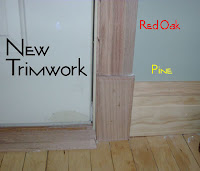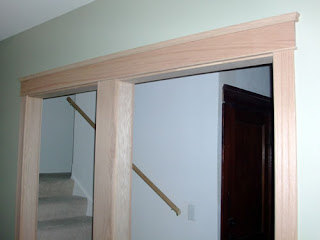Our first floor bathroom (original to our bungalow) has been a utility room of sorts for the last three years. It served as the only bathroom for the first year and a half while we did the second floor. Once that new bathroom was complete and we moved on to redoing out kitchen, our original bathroom became the default utility room.
It was still functional. Indeed, we used the sink as our main source of water for our temporary "college kitchen" while the new kitchen was constructed. But by backing up to the kitchen stove and exhaust hood (and originally on the same electrical circuit), it slowly became part of the construction zone. Coupled with the fact that we started using the bathtub as a utility sink for drywall and painting, it soon became a disaster zone. Especially when we found out about the faulty wiring that was frying slowly in the ceiling!
Enough was enough. We (mostly Jen) were embarrassed to have such a fabulously wonderful new kitchen, only to take a few steps and find a slummed bathroom. So it was with grandiose fervor that Jen announced that the bathroom would be redone prior to our kitchen unveiling party to thank all those who have helped us out.
The plans were to tear up the 1 foot-by-1 foot stick-em tiles that the previous owner had installed, and lay down some ceramic tile, and then replace the 19inch cheapo vanity and fragile medicine cabinet the POs had installed in some half-hearted attempt at "modernizing" the bathroom when they went to sell the house to some unlucky schmucks (which naturally became us). A few weeks ago, to prove her commitment to the project, Jen took up one of the tiles and found another layer of hideous older adhesive tiles underneath. She then panicked, realizing she may have loosed asbestos in the air. A week later with our wallet $80 lighter, we had certified proof from EMSL that the floor/glue was asbestos free. And so began our first real it-could-really-be-done-in-a-weekend-just-like-on-tv-DIY-project.
A few weeks ago, to prove her commitment to the project, Jen took up one of the tiles and found another layer of hideous older adhesive tiles underneath. She then panicked, realizing she may have loosed asbestos in the air. A week later with our wallet $80 lighter, we had certified proof from EMSL that the floor/glue was asbestos free. And so began our first real it-could-really-be-done-in-a-weekend-just-like-on-tv-DIY-project.
We called up some of the usual suspects (Kenny, Scott, Julie) to help us out. Kenny and Jen began removing tiles in the bathroom as we waited for Scott and Julie. Underneath the stick-em and the gaudy 70s non-asbestos gold tile was the original tile floor of the bathroom. As typical for bathrooms in the 1910's, the tiles were small 1" white hexagons set in a deep bed of concrete. I was shocked to see that there were very few that were cracked. In fact the whole floor was very well intact, but had a thick layer of dried glue on it. Jen didn't think it was salvageable (read: pretty) so she and Kenny headed off to buy tile. While they were at the store, Julie showed up at the house, and upon seeing the floor exclaimed, "Oh you guys have to save that!" and grabbed a nearby chisel to start scraping up the old adhesive. As I agreed with Julie, I joined her and before long, we had about a square foot scraped, shiny and glue-free. When Jen came home, Julie convinced her to try refinishing the tile there instead of laying down a new layer on top by offering to do rest of the scraping herself! Jen acquiesced, and Julie and I set back to work.
While they were at the store, Julie showed up at the house, and upon seeing the floor exclaimed, "Oh you guys have to save that!" and grabbed a nearby chisel to start scraping up the old adhesive. As I agreed with Julie, I joined her and before long, we had about a square foot scraped, shiny and glue-free. When Jen came home, Julie convinced her to try refinishing the tile there instead of laying down a new layer on top by offering to do rest of the scraping herself! Jen acquiesced, and Julie and I set back to work.
Then Kenny came in with some lacquer remover, rubbed it on a spot and - voila! - no more adhesive. He started to use it on the rest of the tile and the glue came right up. (This is strong stuff though, let me tell you - lacquer remover is definitely not low-VOC, and in true dad-as-superman-fashion, Kenny insisted on doing the work and having us leave the room so we weren't affected by the fumes. Apparently his lungs and brain cells are made of steel????)
An hour later, the floor had been restored to a lovely white porcelain tile with blue inlay flower patterns that matched the 1952 baby blue bathtub!
So that's the first part of our Bathroom in a Weekend Story - and it was only the first few hours. WHEW! More to come ...
BEFORE

Saturday, March 29, 2008
Bathroom in a Weekend - Part 1: Flooring
Tuesday, March 25, 2008
Thank You for Recycling
In a recent conversation with a Chicago city resident, I was struck by how fortunate Jen and I are to live in a town that not only has a recycling program (Chicago, for all its efforts to become the greenest city in the US, is still woefully lacking in a comprehensive recycling program), but a very good recycling program.
First of all, our recycling containers are big rollaway containers nearly the same size as our regular waste containers, making it attractive to separate and toss things into the big blue bin instead of the waste bin.
But even better, I've learned that most recycling programs generally don't account for all the various types of plastics. Did you know the little triangular Recycle symbol with a number inside it on plastics does not mean it is recyclable? In reality, this symbol is a plastics identification code, hijacked by the plastics industry to mislead consumers. This "code" doesn't tell you the material is recyclable, it merely indicates what type of plastic (the resin) the product is composed of.
In most recycling programs, usually only #'s 1, 2, and 6 plastics are recyclable, but Oak park's recycling program accepts the following plastics.
#1 PETE (plastic soft drink bottles)
#2 HDPE (milk or water jugs, detergent bottles#3 PVC narrow neck containers like household cleaners, health and beauty products
#3 PVC (Narrow Neck Containers Only like household cleaners, health & beauty products)
#4 LDPE (margarine tubs and plastic rings from beverage cans)
#5 PP (yogurt cups, narrow neck syrup and ketchup bottles
#7 OTHER (plastic resin grocery narrow neck containers)
Perhaps best of all, nothing has to be sorted separately, making it easy for those of us who are lazy environmentalists to co-mingle all these plastics together with flattened cardboard packages, newspaper, etc. all in one container. I'm still slowly getting rid of the cardboard protective boxes that surrounded our kitchen cabinets by gradually adding them piece by piece into each week's collection.
I must say that while we don't often wax poetically about the virtues of our city's government, in this instance, our city's recycling program is something that makes me proud to be an Oak Parker. So, thanks Village!
Posted by
jay
at
10:31 PM
8
comments
![]()
Labels: recycling
Tuesday, March 11, 2008
Time for Trim, Craftsman Style
We're down to the final stretch in our kitchen remodel. Those finishing touches that add that extra sparkle to a finished space. Yes, the trim.
I'm glad we remodeled elsewhere in the house first as it's given us perspective and time to figure out how to approach this. And also a chance to research different options. When finishing the basement (our first big project), we went with cheap modern trim options. Not quite as basic as plain ranch casing, but not very consistent with a 95-year-old house either.
However, we wanted our kitchen to flow with the rest of the house, and making the trim similar is an important part of accomplishing this. While we saved all trim that was removed before our remodeling, we quickly realized there would not be enough and without thing feeling too disjointed, we would have to get new trim for most of the kitchen / family room area. Our bungalow has trim pretty consistent with traditional Oak Park area arts and crafts homes, in that the casing for doors and windows is plain and squarish with no mitered corners.



The doorways all have a 9" plinth block at the base to transition from the baseboard trim, which is a 3-piece system of a tall baseboard with a separate curved cap, and then shoe molding along the base (similar to quarter-round) to finish it off. At the tops of the doorways and windows, there are no mitered corners. Instead, the 4" vertical casing ends against a small bullnose piece of trim about 3/8" tall. Above this is a square 1x6 board, with crown molding attached to the top. The trim throughout most of our workingman's home was done in pine or fir instead of the more expensive oak. However, the pine of 95 years ago was old-growth pine, much harder and more durable than today's pine.
During this process, the book The New Decorating with Architectural Trimwork, with detailed descriptions on built-up arts and crafts trim was a great resource in identifying the finer points of our home's style.
A quick trip to the local bigbox hardware stores revealed that it would be tricky if not impossible ot try and replicate this with today's trim options. So it was time to investigate some specialty suppliers. David suggested we check out OWL Hardwood or Hines lumber. Armed with the renovation experience of having to make multiple trips for any given project, I naturally chose the closer of the two. And learning that Hines Lumber also has a commitment to sustainability was a big plus as well. In fact, they even carry Forest Stewardship Council (FSC) rated lumber. While this certified sustainable lumber is intended for framing and not trim work like we needed, it was good to learn they backed up their word and weren't just trying to "greenwash" their business.
Armed with the renovation experience of having to make multiple trips for any given project, I naturally chose the closer of the two. And learning that Hines Lumber also has a commitment to sustainability was a big plus as well. In fact, they even carry Forest Stewardship Council (FSC) rated lumber. While this certified sustainable lumber is intended for framing and not trim work like we needed, it was good to learn they backed up their word and weren't just trying to "greenwash" their business.
One of the other decisions we had to make was to decide whether to go with pine (cheaper) or red oak (more expensive) for the trim options. David mentioned that since both are harvested locally (within 200 miles), the sustainability factor was sort of a toss-up. It really came down to what we could afford and prefer.
After a thorough analysis, we decided to do a mix of woods. All the baseboard trim would be in pine, and all door and window trim would be in oak. That way we could add a greater sense of character to our newly renovated kitchen / family room area and still blend it with the rest of the house. And once the trim is stained, there shouldn't be too much of a difference. From working with the helpful reps at Hines, we were able to find trim profiles that were actually really close to the trim elsewhere in the home. The only thing that is really different is the crown molding profile, but it isn't too noticeable unless you really study the two side by side in the hallway.
From working with the helpful reps at Hines, we were able to find trim profiles that were actually really close to the trim elsewhere in the home. The only thing that is really different is the crown molding profile, but it isn't too noticeable unless you really study the two side by side in the hallway.
Realizing we may have to repaint, we've taken an unconventional approach of installing all the trim before staining and finishing it due to some time constraints we're working with.
There are few more elaborate craftsman-style trim details we plan on stairwell shelves and the column dividing the hall and stairs from the family room, but we'll post more on that another time.
But so far the transformational results have been amazing, and the house really flows well now, with a nice blend between the "old" and the "new."
December 2008 Update: We finally did stain the trim and finish the stairwell.
Posted by
jay
at
7:11 PM
13
comments
![]()
Labels: arches, david, green building, kitchen, trim





